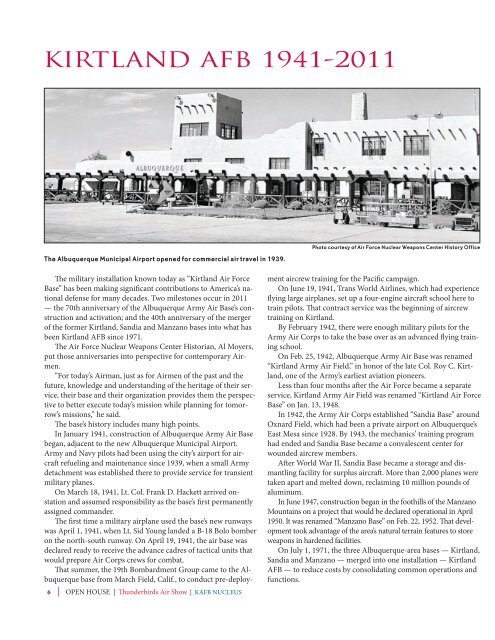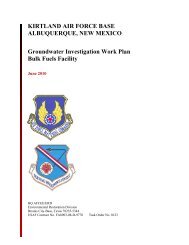Open House doc.indd - Kirtland Air Force Base
Open House doc.indd - Kirtland Air Force Base
Open House doc.indd - Kirtland Air Force Base
Create successful ePaper yourself
Turn your PDF publications into a flip-book with our unique Google optimized e-Paper software.
kirtland afb 1941-2011<br />
The Albuquerque Municipal <strong>Air</strong>port opened for commercial air travel in 1939.<br />
Photo courtesy of <strong>Air</strong> <strong>Force</strong> Nuclear Weapons Center History Office<br />
6 | OPeN HOuse | Thunderbirds <strong>Air</strong> show | KAFB Nucleus<br />
The military installation known today as “<strong>Kirtland</strong> <strong>Air</strong> <strong>Force</strong><br />
<strong>Base</strong>” has been making significant contributions to America’s national<br />
defense for many decades. Two milestones occur in 2011<br />
— the 70th anniversary of the Albuquerque Army <strong>Air</strong> <strong>Base</strong>’s construction<br />
and activation; and the 40th anniversary of the merger<br />
of the former <strong>Kirtland</strong>, sandia and Manzano bases into what has<br />
been <strong>Kirtland</strong> AFB since 1971.<br />
The <strong>Air</strong> <strong>Force</strong> Nuclear Weapons center Historian, Al Moyers,<br />
put those anniversaries into perspective for contemporary <strong>Air</strong>men.<br />
“For today’s <strong>Air</strong>man, just as for <strong>Air</strong>men of the past and the<br />
future, knowledge and understanding of the heritage of their service,<br />
their base and their organization provides them the perspective<br />
to better execute today’s mission while planning for tomorrow’s<br />
missions,” he said.<br />
The base’s history includes many high points.<br />
In January 1941, construction of Albuquerque Army <strong>Air</strong> <strong>Base</strong><br />
began, adjacent to the new Albuquerque Municipal <strong>Air</strong>port.<br />
Army and Navy pilots had been using the city’s airport for aircraft<br />
refueling and maintenance since 1939, when a small Army<br />
detachment was established there to provide service for transient<br />
military planes.<br />
On March 18, 1941, lt. col. Frank D. Hackett arrived onstation<br />
and assumed responsibility as the base’s first permanently<br />
assigned commander.<br />
The first time a military airplane used the base’s new runways<br />
was April 1, 1941, when lt. sid Young landed a B-18 Bolo bomber<br />
on the north-south runway. On April 19, 1941, the air base was<br />
declared ready to receive the advance cadres of tactical units that<br />
would prepare <strong>Air</strong> corps crews for combat.<br />
That summer, the 19th Bombardment Group came to the Albuquerque<br />
base from March Field, calif., to conduct pre-deployment<br />
aircrew training for the Pacific campaign.<br />
On June 19, 1941, Trans World <strong>Air</strong>lines, which had experience<br />
flying large airplanes, set up a four-engine aircraft school here to<br />
train pilots. That contract service was the beginning of aircrew<br />
training on <strong>Kirtland</strong>.<br />
By February 1942, there were enough military pilots for the<br />
Army <strong>Air</strong> corps to take the base over as an advanced flying training<br />
school.<br />
On Feb. 25, 1942, Albuquerque Army <strong>Air</strong> <strong>Base</strong> was renamed<br />
“<strong>Kirtland</strong> Army <strong>Air</strong> Field,” in honor of the late col. Roy c. <strong>Kirtland</strong>,<br />
one of the Army’s earliest aviation pioneers.<br />
less than four months after the <strong>Air</strong> <strong>Force</strong> became a separate<br />
service, <strong>Kirtland</strong> Army <strong>Air</strong> Field was renamed “<strong>Kirtland</strong> <strong>Air</strong> <strong>Force</strong><br />
<strong>Base</strong>” on Jan. 13, 1948.<br />
In 1942, the Army <strong>Air</strong> corps established “sandia <strong>Base</strong>” around<br />
Oxnard Field, which had been a private airport on Albuquerque’s<br />
east Mesa since 1928. By 1943, the mechanics’ training program<br />
had ended and sandia <strong>Base</strong> became a convalescent center for<br />
wounded aircrew members.<br />
After World War II, sandia <strong>Base</strong> became a storage and dismantling<br />
facility for surplus aircraft. More than 2,000 planes were<br />
taken apart and melted down, reclaiming 10 million pounds of<br />
aluminum.<br />
In June 1947, construction began in the foothills of the Manzano<br />
Mountains on a project that would be declared operational in April<br />
1950. It was renamed “Manzano <strong>Base</strong>” on Feb. 22, 1952. That development<br />
took advantage of the area’s natural terrain features to store<br />
weapons in hardened facilities.<br />
On July 1, 1971, the three Albuquerque-area bases — <strong>Kirtland</strong>,<br />
sandia and Manzano — merged into one installation — <strong>Kirtland</strong><br />
AFB — to reduce costs by consolidating common operations and<br />
functions.

















